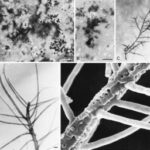Racoleus trichophorus R. Sant. & D. Hawksw., in Hawksworth, Santesson & Tibell, IMA Fungus 2(1): 72 (2011)
Index Fungorum Number: IF 561240; Facesoffungi number: FoF 11087
Etymology: the epithet recalls the spiny hair-like outgrowths.
Thallis lichenibus cum filamentis 7–9 µm latis, et spinis lateralis arcuatis non-lichenibus usque 50–70 × 1.5–3 µm instructis.
Typus – Ivory Coast: Abidjan, in the forest of Banco (ca 5 km north of Abidjan), 5° 30′ N, 4° 0′ W, on trunk of a large tree in a very dark rainforest, overgrowing Dichosporidium brunnthaleri, 29 July 1954, R. Santesson 10344a (UPS-holotypus; GZU — isotypus).
Thallus superficial, forming dense fluffy patches recalling cotton-wool, to 5 mm diam, pale to fuscous brown, filamentous. Photobiont Trentepohlia, single filaments of which are ensheathed by fungal hyphae. Filaments suberect to decumbent or spreading on the surface, sympodially branched, 7–9 µm wide, outer wall undulating and irregularly corrugated, reflecting the morphology of the fungal hyphae, with numerous lateral spines. Hyphae in a single layer surrounding the algal filament, orientated vertically along and always parallel to the axis of the filament, brown, 2–3 µm wide, septate, septa generally 10–15 µm apart, thick-walled, uneven and undulate to corrugated, corrugations tending to interlink with those of adjacent hyphae, not ornamented. Spines arising at broadly acute to almost right angles to the vertical axis, brown, stiff, thick-walled, smooth-walled, not ornamented or corrugated, arcuate to straight, directed outwards and upwards, mainly 50–70 µm in length and 1.5–3 µm wide, gradually tapered towards the tip which is 1–1.5 µm wide, the base expanded into a foot-like cell adhering to the algal filament and measuring 4–7 µm in length. Conidiogenous cells and conidia unknown.
Ecology – All collections are on tree trunks in dense shade in tropical rain forests and on whitish crustose lichens, notably Dichosporidium brunnthaleri, D. nigrocinctum, Pyrgillus indicus, an unidentified arthonioid lichen (probably a species of Cryptothecia). The Racoleus overgrows the crustose lichens and has no intimate contact with them and is easily removed. We do not consider it lichenicolous, and its occurrence on whitish lichens is perhaps a sampling artefact, possibly due to it being more easily visible against a white background.
Distribution – Africa (Ivory Coast), Asia (China), and South America (Peru). The disjunct localities suggest that the species will prove to be pantropical.
Notes – No description of a fungus recalling Racoleus trichophorus could be found in the lichenological or wider mycological literature we examined. However, as we are less familiar with phycological publications, we cannot totally exclude the possibility that the dual organism has been given a name in an old algological work. Santesson (1952: 404) had noted that Dodge (1933: 400) mentioned a filamentous lichen with brown hyphae from Costa Rica, and it is conceivable that it could have been this species, but no illustration was provided, and the material has not been re-examined. Dodge treated this lichen under the name Coenogonium heterotrichum Müll. Arg. (Müller 1893: 162), However, Dodge noted that the species has colourless hyphae. This was confirmed in the type material (Costa Rica: San José: San Marcos de Dota, Tonduz, alt. 1200 m, on thallus of Pyxine sp., 1890, Pitt 6115, G-00293681 — holotype), which has algal filaments with some encrusting hyaline hyphae, some of which grow out away from the filaments, but no regular structure is evident with no brown hyphae or any forming jig-saw like patterns on the surface.
Other specimens examined – China: Yunnan Province: Xishuangbanna District, Jinghong Co., Menglun, Electric Station, Monsun forest valley, 21 ° 55′ N, 101 ° 16′E, alt. ca 500–600 m, on a tree in a rather dark forest in a narrow valley, overgrowing an arthonioid lichen (probably Cryptothecia), 15 Sept. 1987, R. Santesson 32036b (UPS). — Peru: Dept. Loreto: Iquitos, Explorama Lodge (ca 50 km NE of Iquitos), Lake Trail, 3 ° 27′ S 72 ° 57′ W, alt. ca 100 m, on a tree trunk in a tropical rainforest, overgrowing Dichosporidium nigrocinctum, 23 Jan. 1981, R. & B. Santesson P7:4 (K(M) 165036, S, UPS); Dept. San Martin: Prov. Lamas, Cerro Blanco (ca 63 km on road W-WNW of Tarapoto), ca 6 ° 25′ S 76 ° 40′ W, alt. ca 1200 m, on a tree trunk in a dark rainforest, overgrowing Pyrgillus indicus, 17 Mar. 1981, R. Santesson & G. Thor P77:11 (S, UPS).

Figure 1 – Racoleus trichophorus. A, B. Habit, overgrowing Dichosporidum brunnthaleri on bark. C, D. Detail of lichenized filaments. E. SEM micrograph showing the dentate walls of the hyphae over the algal filament and the characteristic lateral spines. A-D (Santesson 10344a, UPS — holotype), E. (Santesson P7:4, UPS). Bars A = 225 µm, B = 50 µm, C = 14 µm, D = 7 µm, E = 2 µm.
